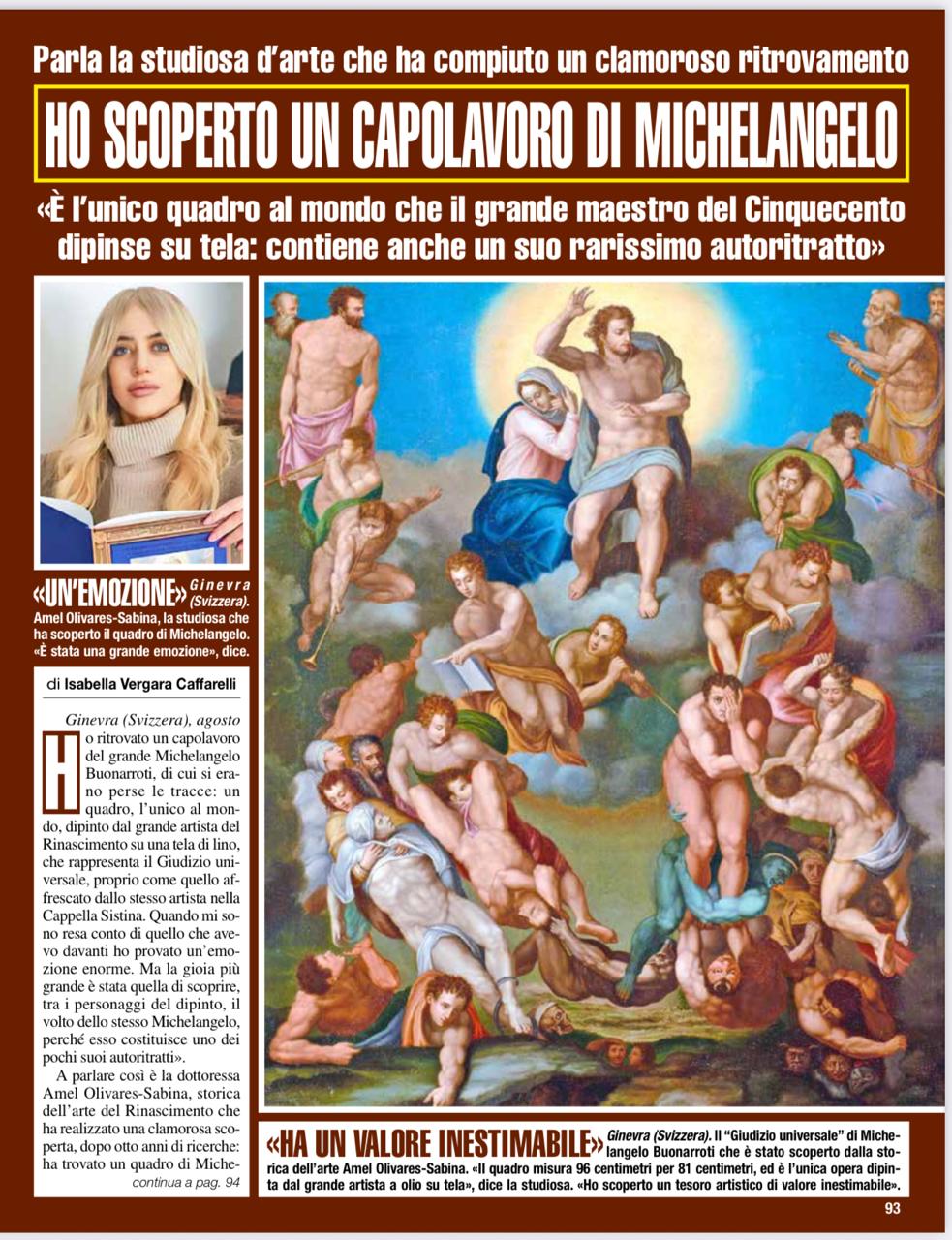Miguel Angel Buonarotti
Miguel Angel Buonarotti - El juicio final
Miguel Angel Buonarotti - El juicio final
Couldn't load pickup availability
El juicio final , atribuida a Miguel Angel Buonarotti
Óleo sobre lienzo
Altura 96,52cm. x ancho 81,28cm.
Diseño ( boceto ) realizado para la capilla Sixtina
INTRODUCTION AND CONCLUSIONS OF THE LAST JUDGEMENT OF GENEVA
AUTHENTICATION REPORT
Foreword:
The rediscovery of the “Last Judgment of Geneva” sketch holds an extraordinary artistic and
historical value. Since the “Last Judgment of Geneva” is Michelangelo's only known oil-oncanvas
artwork, there were no other paintings by the artist that could serve as direct
references for a proper comparison. As my research continued, the details of Buonarroti's
work on canvas were gradually revealed: I based my analysis not only on a thorough study of
his panel paintings, pigment use, and overall technique but also on the knowledge I gained
from examining Raphael's oil-on-canvas works. A few years back, I carefully studied two
Italian Renaissance oil-on-canvas paintings by the Master of Urbino: a “Holy Family,” which
features the Virgin Mary, St. Elizabeth, Infant John the Baptist, and Child Jesus, along with his
renowned “Portrait of Baldassarre Castiglione,” one of the masterpieces housed in the Louvre
Museum in Paris. Both canvases share a preparation-imprimatura matching that of the “Last
Judgment of Geneva.” The novelty was the use of lead carbonate (white lead), which was
applied extensively to canvases for practical reasons as well, only using calcium carbonate, as
was common on Renaissance panels, the canvas could not be rolled without cracking, making
transport easier. In the “Portrait of Baldassarre Castiglione,” Raphael chose a fine linen canvas
of excellent quality, a feature also found in the medium of the “Last Judgment of Geneva.” In
this painting by Raphael, the preparatory layer consists of white lead mixed with brown, red,
and black earth pigments. As you will appreciate in Chapter 2 - Chemical Analysis of the “Last
Judgment of Geneva”: Stratigraphy, Spectrophotometry (XRF), the white lead in the “Last
Judgment of Geneva” contains minimal amounts of red-brown earths and bone blacks,
resulting in virtually identical compositions. In the “Portrait of Baldassarre Castiglione,”
Raphael employed very thin pictorial layers, a feature also seen in the “Last Judgment of
Geneva.”
I remember that when I began my research ten years ago, many experts criticized the
presence of white lead in the canvases I studied, as they associated Raphael and Leonard
(both symbols of the Italian Renaissance) with the use of panels and their canvases
preparations based on calcium carbonate (while completely disregarding the Venetian
school). Therefore, this research introduces a new chapter on Michelangelo Buonarroti's
artistic work, providing unpublished details.
Hence, the research to verify the authentication of the “Last Judgment of Geneva” makes a
valuable contribution to understanding Michelangelo's work and can serve as a helpful
resource for other art experts and scholars in their studies.
The “Last Judgment of Geneva” painting sketch, preserved in the city of Geneva, had been lost
amid the complex twists and turns of its ownership history. Based on evidence from
testamentary and inventory records (particularly those of the Guadagni family, as we will see
later), the painting was often described as a sketch featuring religious figures, a tactic used to
avoid higher taxes on artworks in private collections.
No historical or archival research has ever examined Michelangelo Buonarroti's sketch (“the
Last Judgment of Geneva”), which served as a model for Alessandro Allori (1535-1607)
to create his “Last Judgment” Altarpiece in the Basilica della Santissima Annunziata in
Florence, and where the young Florentine painter, in his early twenties, states in a Latin note
Modern historians could not be aware of Michelangelo's connection to Alessandro Allori, the
true story behind the “Last Judgment” Altarpiece, Buonarroti’s relationships with Rome’s
wealthiest and most prominent Florentine families, or other details about his painting
technique.
The “Last Judgment of Geneva” is a composition depicting Michelangelo’s “Last Judgment” in
the Sistine Chapel, but with fewer figures, specifically 33. It is a sketch where the positioning
of the characters is very similar to that of the Sistine fresco, namely: Christ the Judge at the
top center with the Virgin Mary, the “Saved” below on the right side, including Michelangelo's
self-portrait, and the “Damned” on the left.
The sketch, as mentioned earlier, was a gift from Michelangelo to the young Alessandro
Allori, the putative son of the renowned Florentine painter Agnolo Bronzino, also known as il
Bronzino (1503-1572). Allori allegedly used the sketch as a model for painting the altarpiece
that would grace the private chapel of the distinguished Montauto family in the Basilica della
Santissima Annunziata in Florence. The discovery of this sketch is of utmost importance
because its whereabouts had been unknown since the late 19th century.
The story of the arrival of the “Last Judgment of Geneva” in Florence can be situated around
1560, when Alessandro Allori returned to beautiful Florenzia from Rome, with all the honors
and respect owed to him by his fellow citizens for having worked directly with the renowned
Michelangelo Buonarroti.
Allori moved to Rome in 1554 to study the works of the great Renaissance masters, especially
Michelangelo with whom he established a genuine friendship based on mutual respect and
admiration, beyond a typical master-pupil dynamic, as evidenced by Varchi's letter to
Buonarroti: “(…) come laringrazio (…)el favore che ella, per somma bontà et amorevolezza
Share






























